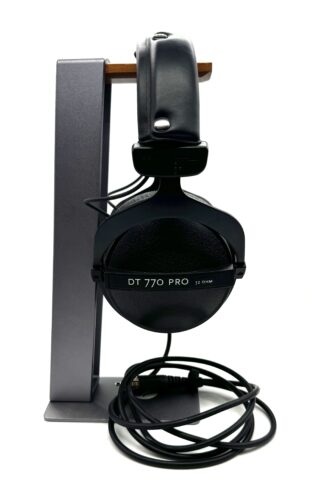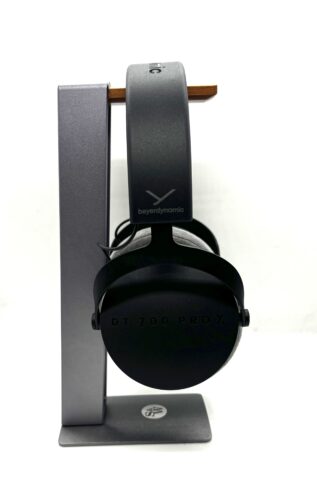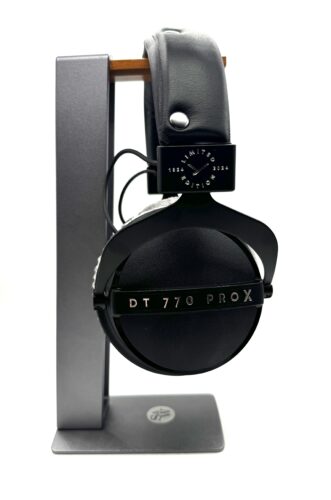We recently reviewed the Beyerdynamic DT 770 Pro X Limited Edition headphones here on MajorHifi. In that review, we got into the specifics of the new headphone. However, we wanted to do a more thorough comparison between the classic DT 770 Pro 32 Ohm headphone and the newer DT 700 Pro X headphone. The reason being that the DT 770 Pro X LE is a new model of the older, but still beloved classic. And at the same time, the DT 770 Pro X LE uses the same driver technology and has some similar features to the DT 700 Pro X.
What’s in the Box:
| 770 Pro 32 Ohm | 700 Pro X | 770 Pro X LE |
|
|
|
Look and Feel
These three headphones share similar basic design elements like shape, feel, and materials. But other than that, each headphone has its own unique thing going on. The DT 770 Pro 32 Ohm has a line across the cup saying its name. On the ear cup is a kind of textured feeling surface. The 32 Ohm uses leather ear pads and has a leather, cushioned headband. It comes in at a very light 270 grams. Unfortunately, it does not have a detachable cable.
That brings us to the DT 700 Pro X, which introduced a detachable cable in 2021. The cups on the headphone are matte black and the earcups employ velour pads. Its headband goes for a sleeker look with the name “Beyerdynamic” on the top. Build quality is top notch (the same goes for all three sets). But these velour ear pads make for a much more comfortable listening experience. They do weigh 350 grams, which makes them the heaviest of the three. But I didn’t find these too heavy by any stretch. They’re all pretty light and comfortable.
And finally, the DT 770 Pro X incorporates design features from the first two mentioned. You’ll find that the DT 770 Pro X borrows a lot from each headphone. For example, the name. “DT 770 Pro” comes from the earlier headphone’s lineage, while the “X” seems to come from the DT 700 Pro X. Following this pattern, the DT 770 Pro X uses the same buttoned leather headband as the DT 770 Pro 32 Ohm while still incorporating the “Beyerdynamic” name on the top. Its ear cups follow the design of the 32 Ohm model while using the velour ear pads of the DT 700 Pro X. But like that headphone, the DT 770 Pro X uses a detachable cable. At 305 grams, it’s comfy, sturdy, and the best of both headphones.
Design
While all three headphones are closed-back and relatively easy to drive, the DT 770 Pro 32 Ohm stands apart from the other two models with its driver. But while it’s a pretty low impedance, the SPL is quite low at 96 dB/mW. At the same time, the DT 770 Pro X LE and DT 700 Pro X each come in at 48 ohms, using the same Stellar.45 driver. However, these have a slightly higher SPL at 98 dB/mW and 100 dB/mW respectively.
In practice, I found the new DT 770 Pro X LE and DT 700 Pro X to be easier to drive, but marginally so. If you’re looking to run any of these models straight out of your phone or computer, you’ll have no problem. That said, they all benefit from a little juice, helping improve bass extension, detail, and separation. A simple dongle DAC/Amp should serve any of these headphones just fine.
Sound Comparisons

DT 770 Pro 32 Ohm:
The original DT 770 Pro model has a mostly balanced, but slightly U-shaped sound signature. That U-shape is tasteful however as these are ultimately made for professional reference use. I find the bass to be fast and nimble without taking up too much space. Extension is deep and the midbass is clean but present. I’d also say that this is probably the best of the three when it comes to transients and bass impact. Likewise, dynamics are really good on this headphone.
Like I said, the headphone is slightly U-shaped, but that doesn’t mean the mids face any sort of steep recession. It’s a calm and detailed midrange with great separation. Listening to some more complex passages in Radiohead’s discography, I got a good sense of midrange placement. This comes from a good sense of imaging as well, and you’ll find all three pairs of these headphones to be great for imaging.
Strong treble is a signature feature on Beyerdynamic headphones, and that is the case here as well. That said, I don’t personally have any problems with the treble response here. It has plenty of headroom, and I find it quite resolving rather than shrill or sibilant.
Soundstage is solid, but imaging is where this headphone does its best job of placing audio. In fact, imaging is superb across all three headphones. This is important for professional use as well as audiophile use as the imaging feels accurate and not artificial. It’s natural and you can trust that things are where they’re designed to be in the studio.

DT 700 Pro X:
This headphone takes a slightly different approach to its sound signature. Unlike the U-shape of the DT 770 Pro 32 ohm, its bass is a bit more in line with the mids. There’s less subbass extension than the first headphone we discussed as well as a dip in the midbass region. For me, I would have liked a little bit more bass to balance out the top end of the headphone. But we’ll get to that in a little bit.
The midrange is very similar to the DT 770 Pro 32 Ohm model. It’s not quite forward but it’s neutral and accurate. There’s similar quality detail retrieval here. Vocals are, again, accurate and linear without any added warmth. This headphone is probably the most neutral of the three.
Finally getting to the treble, I find things to be a little sharp. I think this comes from a lack of low end balance making the treble come across as forward. It’s still resolving rather than sibilant but just a little bit askew compared to the bass and mids. But the treble is where the detail comes from with Beyerdynamics, and with that, these are probably the most detailed headphones of the three. There isn’t any bass or midrange bloat to cover anything up.
All that said, I think this headphone is best for those who prioritize details in their listening experience. You’ll get good soundstage and imaging and accuracy above all. But you might miss out on the dynamic low end punch that you can find in the other two headphones.

DT 770 Pro X Limited Edition:
On the new limited edition headphones, we get the best of both worlds from the first two. Bass is a little closer to the 32 Ohm. This model is more forward than the 700 Pro X and has a nice sense of dynamics to it. It’s not quite as strong as the 32 ohm version but it’s more controlled and nuanced, with nice low end details becoming apparent where they weren’t on the other two. Things separation, impact, and speed are just better on this model.
The midrange is, once again, linear. It’s probably the factor all three headphones have most in common. No coloration here, but there is plenty of body to the vocals, and separation is once again great.
The top end is closer to the DT 700 Pro X, though I don’t find it as sharp because there’s a little more balance to the sound on this model. Detail remains top notch and imaging and soundstage remain solid for the price point.
Final Thoughts
Overall, I think the DT 770 Pro X Limited Edition strikes the perfect combination of elements from its predecessors. It has the detachable cable of the DT 700 Pro X while keeping the classic looks of the DT 770 Pro 32 Ohm. The LE model keeps the top end detail of the Pro X while mixing in the low end balance of the 32 Ohm. The headphone offers a great reference tuning without breaking the bank, and if I was choosing between the three, I wouldn’t hesitate to jump for the DT 770 Pro X Limited Edition.
That said, the other two are no slouches. The 770 Pro 32 Ohm is a bit more exciting and fans of a U-Shape sound signature may prefer that for casual listening. On the other hand, the 700 Pro X is a detail machine, and people who want to maximize that retrieval may want to go that route. That’s the beauty of audio – it’s all subjective and there’s something out there for everybody. With the new Limited Edition DT 770 Pro X, Beyerdynamic honors its legacy by pushing its classic products even further.
You can find the Beyerdynamic DT 770 Pro 32 Ohm, DT 700 Pro X, and DT 770 Pro X Limited Edition all at Audio46.
MAJORHIFI may receive commissions from retail offers.









